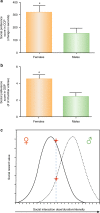Sex-dependent regulation of social reward by oxytocin: an inverted U hypothesis
- PMID: 29968846
- PMCID: PMC6235847
- DOI: 10.1038/s41386-018-0129-2
Sex-dependent regulation of social reward by oxytocin: an inverted U hypothesis
Abstract
The rewarding properties of social interactions are essential for the expression of social behavior and the development of adaptive social relationships. Here, we review sex differences in social reward, and more specifically, how oxytocin (OT) acts in the mesolimbic dopamine system (MDS) to mediate the rewarding properties of social interactions in a sex-dependent manner. Evidence from rodents and humans suggests that same-sex social interactions may be more rewarding in females than in males. We propose that there is an inverted U relationship between OT dose, social reward, and neural activity within structures of the MDS in both males and females, and that this dose-response relationship is initiated at lower doses in females than males. As a result, depending on the dose of OT administered, OT could reduce social reward in females, while enhancing it in males. Sex differences in the neural mechanisms regulating social reward may contribute to sex differences in the incidence of a large number of psychiatric and neurodevelopmental disorders. This review addresses the potential significance of a sex-dependent inverted U dose-response function for OT's effects on social reward and in the development of gender-specific therapies for these disorders.
Conflict of interest statement
The authors declare no competing interests.
Figures







References
Publication types
MeSH terms
Substances
Grants and funding
LinkOut - more resources
Full Text Sources
Other Literature Sources
Research Materials
Miscellaneous

